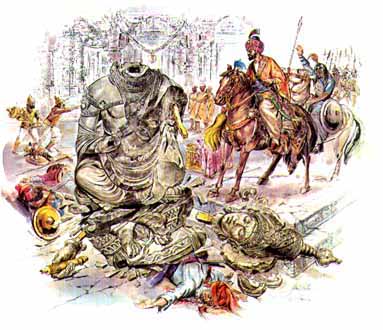CONQUEST OF SOMNATH: 998-1038 A.D.
|
CONQUEST OF SOMNATH: 998-1038 A.D. |
|
Sebuktigin succeeded to power at Ghazni in 962 and started vigorously to expand his dominion. Jayapal of Hind saw danger in the consolidation of the Kingdom of Ghazni and decided to destroy it. He invaded, but was defeated and agreed to pay an indemnity. He defaulted, took to field again and was once more defeated.
The great Sultan Mahmud of Ghazni, who made the name of the Ghaznavids famous in Asia, succeeded his father. Jayapal stopped indemnity. Mahmud defeated him in 1001 and he immolated himself by fire. Later, Jayapal's son Anandapal, formed a confederacy of the Hindu rulers of Ujjain, Gwalior, Kalinjar, Kannawj, Delhi & Ajmer. The confederacy was also beaten by Mahmud at Peshawar in1008 and Sultan appointed a governor to reside at Lahore. Mahmud made 17 invasions. Nagarkot, Thanesar, Kannawj and Kalinjar were all conquered but left in the hands of the Hindu vassals. His most famous attack was the one on Somnath, famous place of Hindu worship in Gujrat, Kathiawar. Crossing the difficult Rajputana desert, he reached there and faced the combined forces of almost all the Hindu rajas of India. He was a great military commander and his courage knew no bounds. He defeated them, captured the city and entered the temple. Mahmud was offered fabulous wealth not to enter the temple and destroy the idols, but he refused. He said that he should be known in the history as ' destroyer of idols and not the trader '. The great Sultan at the height of his power ruled over the area between the Jamuna in India and the Tigris in the West. |

